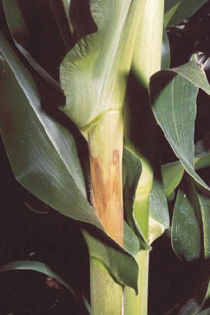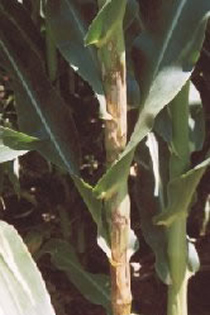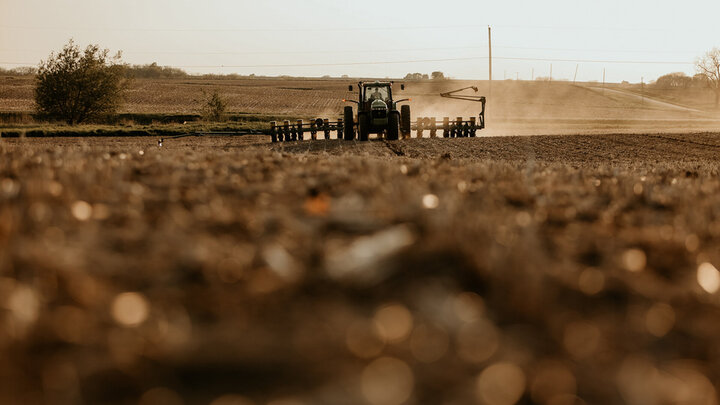Original content created by Dr. Jim Stack, former UNL Extension Plant Pathologist currently Kansas State University Extension Plant Pathologist. Content edited and approved by Dr. Tamra Jackson, UNL Extension Plant Pathologist.
Pathogen
Erwinia chrysanthemi pv. zeae (Sabet) Victoria et al. is a motile, gram-negative, rod shaped bacterium. It is commonly found throughout the corn belt of the USA and periodically causes outbreaks. In 2001, an outbreak occurred in Gosper, Phelps, and Kearney Counties of Nebraska. At least thirteen pivot/sprinkler irrigated fields had incidences of bacterial stalk and top rot in the range of 2 to 25%.
Bacterial top rot can be caused by different species of bacteria. Erwinia chrysanthemi pv. zeae is most often associated with this disease although Erwinia carotovora subsp. carotovora (Jones) Bergey et al., Enterobacter dissolvens (Rosen) Brenner et al., and Pseudomonas aveae subsp. avenaeManns have also been reported as causal agents. These bacteria survive in corn and sorghum stalks and residue. The bacteria enter the plants through natural openings; wounds from hail, high winds, or insect feeding (e.g., stalk borers) can provide additional entry sites into the plant.
Disease Symptoms
The initial symptom is discoloration of the leaf sheath and stalk at a node. As the disease progresses, lesions develop on the leaves and sheath. Disease then develops in the stalk and rapidly spreads up the stalk and into the leaves. As the decay progresses, a foul odor can be detected and the top of the plant can be very easily removed from the rest of the plant. The stalk rots completely and the top collapses. Bacterial stalk rot can affect the plant at any node from the soil surface up to the ear leaves and tassels. Infections that occur high on the plant may impair normal tasseling and affect subsequent pollination. Although it may spread along the plant to infect additional nodes, the bacteria do not usually spread to neighboring plants unless vectored by an insect. Splitting the stalk reveals internal discoloration and soft slimy rot mostly initiating at the nodes. Because the bacteria usually do not spread from plant to plant, diseased plants are quite often found scattered throughout the field. However, there are reports of plant-to-plant transmission by certain insect vectors.










Favorable Environmental Conditions
Bacterial stalk and top rot is favored by high temperatures and high relative humidity. It can be a problem in areas of heavy rainfall or where overhead irrigation is used and the water is pumped from a lake, pond, or slow-moving stream.
Management
Genetic Resistance
Hybrid resistance has been reported but because this disease occurs so infrequently, resistance genes are not routinely bred into hybrids and resistance ratings are not usually reported.
Cultural Practices
Management of bacterial stalk and top rot includes fall cultivation to incorporate residue and avoiding excessive irrigation or flooding.
Links
Common Stalk Rot Diseases of Corn, EC1898.








